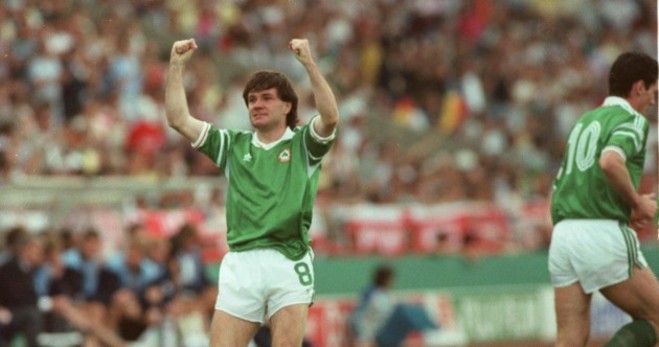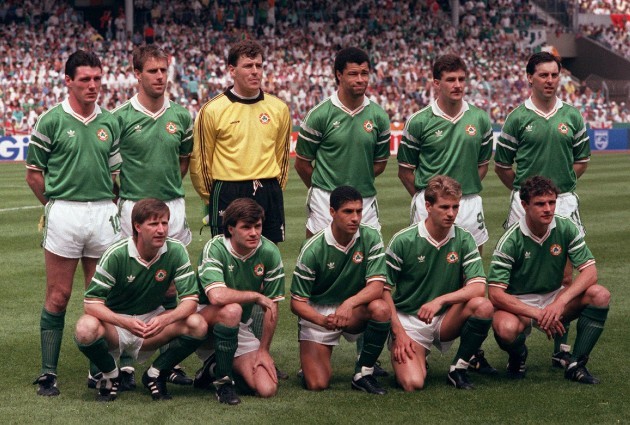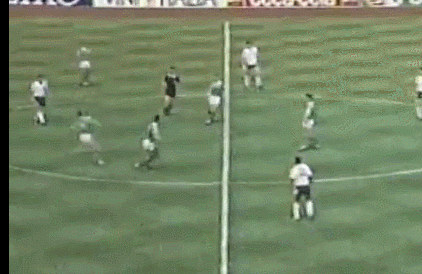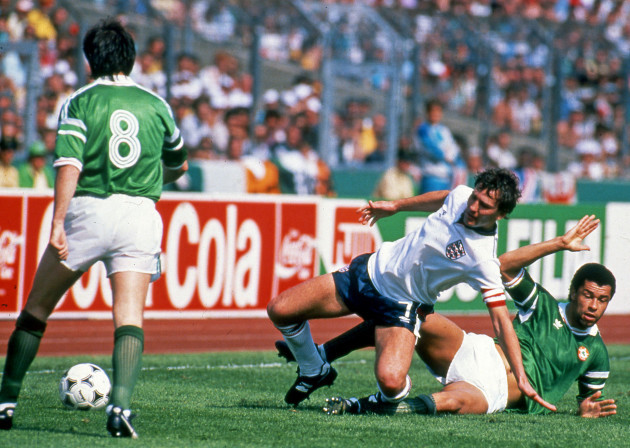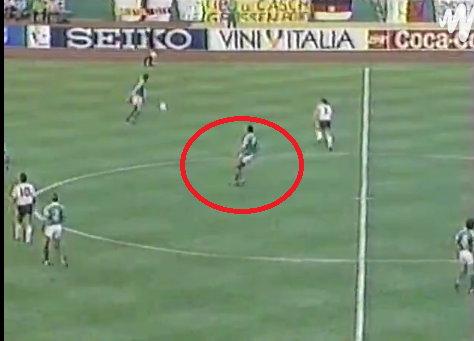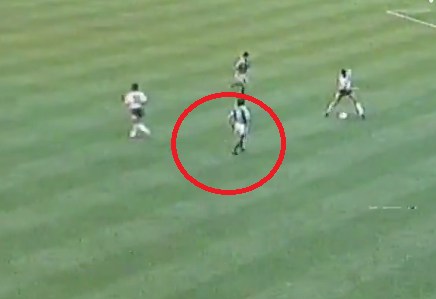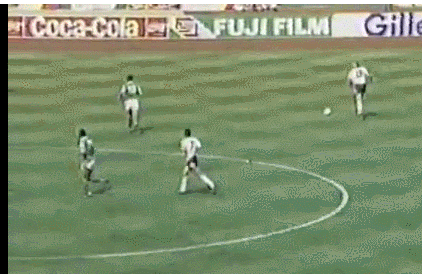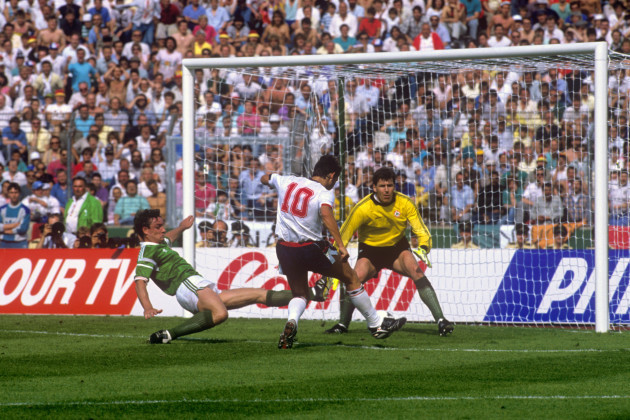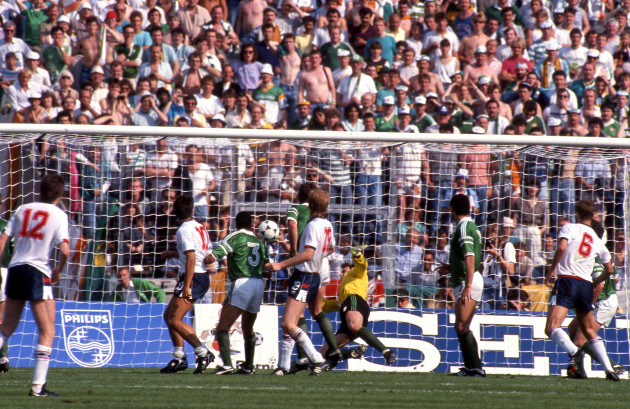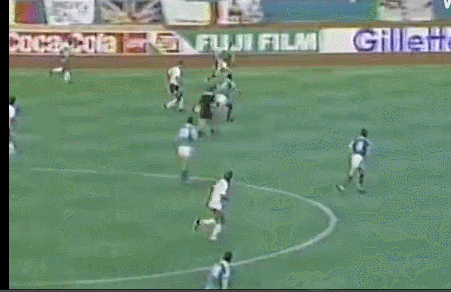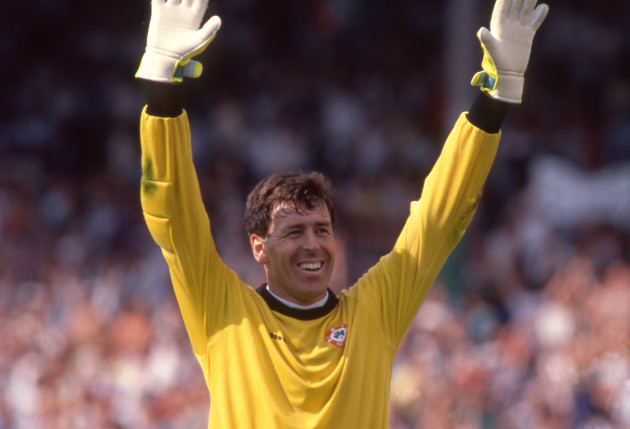IRELAND’S FIRST-EVER appearance at a major tournament is 28 years old on Sunday.
The first game was also a memorable result to say the least — a 1-0 win against a much-fancied English side in the European Championships in Germany on 12 June 1988.
Consequently, to mark the game’s anniversary, we’re taking an in-depth look at how Ireland managed to pull off this improbable success.
Background
England went into the match as strong favourites. Indeed, after an impressive qualification campaign that saw them drop points in just one match (against Turkey), they were deemed second favourites behind Germany to win the tournament outright, while Ireland had scraped through a very difficult group thanks to Scottish player Gary Mackay’s famous goal in Bulgaria (see below).
Both sides had problems ahead of the encounter. Undoubtedly the biggest star in the Irish team at the time, Liam Brady was ruled out of the tournament through injury (he would have missed the first two matches through suspension anyway and had a famously indifferent relationship with manager Jack Charlton). Mark Lawrenson was also unavailable through injury, while Terry Butcher, Trevor Steven and Dave Watson had all been ruled out for England.
Kevin Moran has spoken of how Irish players joked before the game that they’d be lucky to keep the scoreline down to 3-0, but there was certainly an element of apprehension or fear at potential embarrassment before.
In addition, working as a TV pundit, Brian Clough epitomised England’s confidence ahead of the match, suggesting Irish centre-back Mick McCarthy was not “international class” (see above) and indicating that the English side could exploit this weakness.
The moment ultimately turned out to be a little reminiscent of when the legendary manager branded Polish goalkeeper Jan Tomaszewski a “clown,” only for the stopper to excel at Wembley in 1973 and knock England out of the World Cup qualifiers in the process. McCarthy, likewise, ultimately silenced his critics with a commanding display at centre-back.
Teams and formation
Ireland began with a 4-4-2. Packie Bonner was between the posts, while the back four comprised of Chris Hughton, Mick McCarthy, Kevin Moran and Chris Morris. Paul McGrath and Ronnie Whelan were the central midfielders, with the former invariably sticking close to the back four. Tony Galvin and Ray Houghton were out wide, with the latter tending to float and join up with the attack at times, as illustrated by his famous goal. Meanwhile, John Aldridge and Frank Stapleton were the two forwards expected to run their socks off thanklessly up front.
For England, Peter Shilton was in goals, with Kenny Samson, a 21-year-old Tony Adams, Mark Wright and Gary Stevens making up the defence. Neil Webb was preferred to Glenn Hoddle in midfield alongside Bryan Robson, while Chris Waddle and John Barnes were on the wings. Peter Beardsley played in the number 10 role slightly behind striker Gary Lineker.
Bright Irish start
The tone was set by the Irish side early on. Tony Cascarino chased a powerful header forward, forcing the backtracking Tony Adams to nervously kick the ball out of play (see clip below). This passage of play was the opening stages in microcosm, as an unconvincing English defence failed to adequately cope with Ireland’s classic ‘put-‘em-under-pressure’ approach.
Ireland simply looked sharper and livelier in the opening stages, and they were rewarded with the opening goal on six minutes. Typically, it emanated from a long punt, as Wright and Stevens got in each other’s way going for the same ball.
Tony Galvin’s subsequent cross caused further chaos, with Kenny Samson mis-hitting an attempted clearance before Aldridge outjumped Adams, nodding the ball towards Houghton, who expertly headed it into the far corner of the net in what would later become renowned as one of the most iconic moments in Irish sporting history.
English struggle to create chances
After the goal, the English team seemed to take a while to recover from the shock of conceding.
The Irish sat back and were perfectly willing to soak up the English pressure. Their opponents, meanwhile, though they dominated possession, offered little in the way of attacking incision.
There were some recurring themes in the first half. Bonner’s abnormally long kick-outs that would consistently go deep into the English half, Aldridge and Stapleton feeding off scraps, McCarthy and Moran heading the ball away virtually every time Bobby Robson’s men threatened to make inroads into Ireland’s final third, aimless English passing causing attacks to fall flat and jubilant Irish fans singing their hearts out throughout.
Hence, for the 45 minutes, England seldom looked like breaking their rivals down, as star players from that era including Gary Lineker, Chris Waddle, Peter Beardsley and John Barnes were made to look ordinary by a determined Irish rearguard. The Three Lions were frequently pressed even deep in their own half by the determined Ireland attackers.
The English team struggled to get any real rhythm in their game. Paul McGrath did a fine job sitting in front of the defence, while Ray Houghton — usually the most advanced Irish midfielder — was seemingly tasked with stopping England from starting attacks.
The fact that the Lineker chance in the clip below was the closest the favourites came to breaking the deadlock in the opening period speaks volumes about how well the Irish team closed the space and heavily restricted a highly talented English outfit.
The Irish, originally widely considered to be making up the numbers in what was an eight-team tournament back then, were suddenly proving to the world that they deserved to be taken seriously, with a well-organised display filled with discipline, commitment and courage.
The back-pass rule and alleviating the pressure
One curiosity in viewing this game in a modern context is the palpable absence of the back-pass rule, which was only introduced to football in 1992.
The Irish side certainly benefited on more than one occasion in Stuttgart by being able pass the ball back to Bonner and alleviate some of the intensive English pressure.
It’s also perhaps not a complete coincidence that the rule’s onset coincided with Jack Charlton’s side’s fortunes dipping gradually.
Following the rule’s arrival in football, Ireland could no longer rely on Bonner’s long kick-outs quite so often. Moreover, Ireland were primarily a side based around a solid defence, and the implementation of the rule made life considerably more difficult for big, awkward centre-backs who could no longer rely on the get-out clause of passing the ball back to the goalkeeper in the knowledge that he could comfortably collect it with his hands.
Furthermore, while it hardly reached modern Atletico Madrid-esque levels of cynicism and there were certainly no feigning of injuries, the Irish team did find subtle ways of slowing the game down, frustrating the English side by taking a few extra seconds for a free-kick or throw-in, or stopping a marauding run with an unforgiving challenge.
Irish luck prevails in the second period
While the Irish back four seldom looked troubled in the first half, the same could not be said after the interval.
Lineker’s movement was starting to cause problems, as the English side’s dominance intensified. At one point, the then-Barcelona star found a yard of space, before unleashing a powerful half-volley. Bonner could only parry the ball into the path of the onrushing Beardsley, who proceeded to blast it over the bar from close range.
It was one of many chances missed by the English, with even Jack Charlton and Irish players acknowledging after the game that they rode their luck a little at times.
Lineker was particularly wasteful — a surprise, given that the English striker had come off two successful seasons at Barcelona, in which he had managed 36 goals in 77 La Liga matches.
Nevertheless, a Guardian recollection of the game notes how the England star was later diagnosed with hepatitis B, which perhaps partially explains his uncharacteristic sloppiness in front of goal amid an afternoon in which little went right for the English.
Hoddle makes an impact while Ireland threaten sporadically
In contrast with their lack of imagination in the first half, England finally began to spring some meaningful passes together after the break.
Their increasing superiority can partially be put down to wary Irish legs struggling to maintain the intensity of the opening 45 minutes amid a humid afternoon in Stuttgart. This tiredness meant they failed to close the spaces as adequately as before, with gaps starting to appear for the English to exploit.
Hoddle made his presence felt early on, while Chris Waddle also came into the game more, as his clever lofted ball put Lineker through on goal, but the future Match-of-the-Day host failed to hit the target with the goal at his mercy.
With Hoddle pulling the strings, England were belatedly starting to show the type of creativity they had so patently lacked in the opening period. The only issue was that as desperately as they tried, they simply couldn’t put the ball in the back of the net.
For the most part, Ireland’s attacking threat was minimal, as they devoted most of their energy towards stopping England from playing.
The English side did have a few second-half scares, however. Shortly after the hour mark, England’s shaky defence again failed to properly deal with Ireland’s considerable aerial threat from a free kick delivered from deep. The ball subsequently fell to Ronnie Whelan, whose volley from the edge of the area rocketed off the cross bar.
Furthermore, later on in the game, Houghton again demonstrated his knack for being in the right place at the right time, but on this occasion, his side-footed finish went narrowly wide.
In addition, substitute Niall Quinn also had a half-chance in the late stages, but the then-Arsenal striker headed wide.
Anxious final moments
After a 15 to 20-minute spell when an English goal looked inevitable, Ireland appeared to have ridden the worst of the storm, and the game fell into another lull as the final whistle approached.
It seemed as if the English had been deprived of morale and ideas. Such was the Boys in Green’s confidence that they were happy to put bodies forward in attack even in the dying minutes of the game as a glorious victory was suddenly within sight.
What’s notable in retrospect is how rigidly the Irish side stuck to the long-ball game, even when it was unquestionably to their detriment to do so. For instance, on more than one occasion in the dying moments, an Irish individual belts the ball away when they clearly had an opportunity to hold onto the ball with space to run into, thereby potentially running down the clock in the process.
Perhaps it was a sign of how utterly shattered they were after such an exhausting game, or their nervousness at the thought of being on the brink of history, but their tendency to almost automatically give the ball straight back to England only served to amplify the pressure on their goalmouth in the dying moments.
Consequently, there was one final let-off for Charlton’s side. After McCarthy recklessly fouled Lineker, a free-kick was hopefully booted into the penalty area. The Barcelona man produced a powerful header, but Bonner completed a superb day’s work, as a sharp reaction save turned the ball away from goal and out for a corner. Lineker’s woe was encapsulated as he covered his face in exasperation, and seconds later, history was made.
Conclusion
28 years later, the defeat of England still feels as special and unique as ever.
Ireland winning the match was a remarkable achievement under the circumstances. To beat the second favourites on your first appearance at a major tournament is no mean feat, particularly when it’s a side with stars of the calibre of John Barnes, Tony Adams and Peter Beardsley.
There is no doubt that luck played a part in the outcome, with Lineker in particular having a torrid time in front of goal.
But, while it’s so familiar that it’s become clichéd at this stage, this memorable match really was one of the earliest examples of the indefatigable Irish spirit, which has become synonymous with football on these shores ever since, and in particular, with the best days of the Charlton era.
While Houghton showed great composure and opportunism for the goal following an exuberant Irish start, there is no doubt the victory was built on hard running and chasing the English down, forcing great players on the opposition side into sloppy, uncharacteristic errors.
The Boys in Green looked to be running on empty as the English finally began to gain a stranglehold on proceedings in the second half, but another burst of adrenaline was enough to get a tiring Irish outfit over the line, with the brilliant Bonner compensating for any momentary defensive lapses in concentration.
Bobby Robson’s men never really recovered from this early blow, exiting the competition in ignominy after three consecutive defeats, which made a mockery of the huge sense of optimism surrounding the team at the outset of the tournament.
Ireland, meanwhile, would also fail to win their subsequent matches, but they were desperately unlucky in both instances, with a late Wim Kieft goal (see above) denying them a semi-final spot and ensuring that the two eventual finalists — Holland and Soviet Union – progressed from the group.
It was an odd set of circumstances, as the Irish side had arguably performed better against both Holland and Soviet Union compared with the somewhat fortuitous English win, and yet the outcome was less favourable on both occasions.
So, as George Hamilton noted in a 2012 oral history published on this site: “We won the game we should have lost, drew the game we should have won and lost the game we should have drawn.”
The42 is on Snapchat! Tap the button below on your phone to add!
